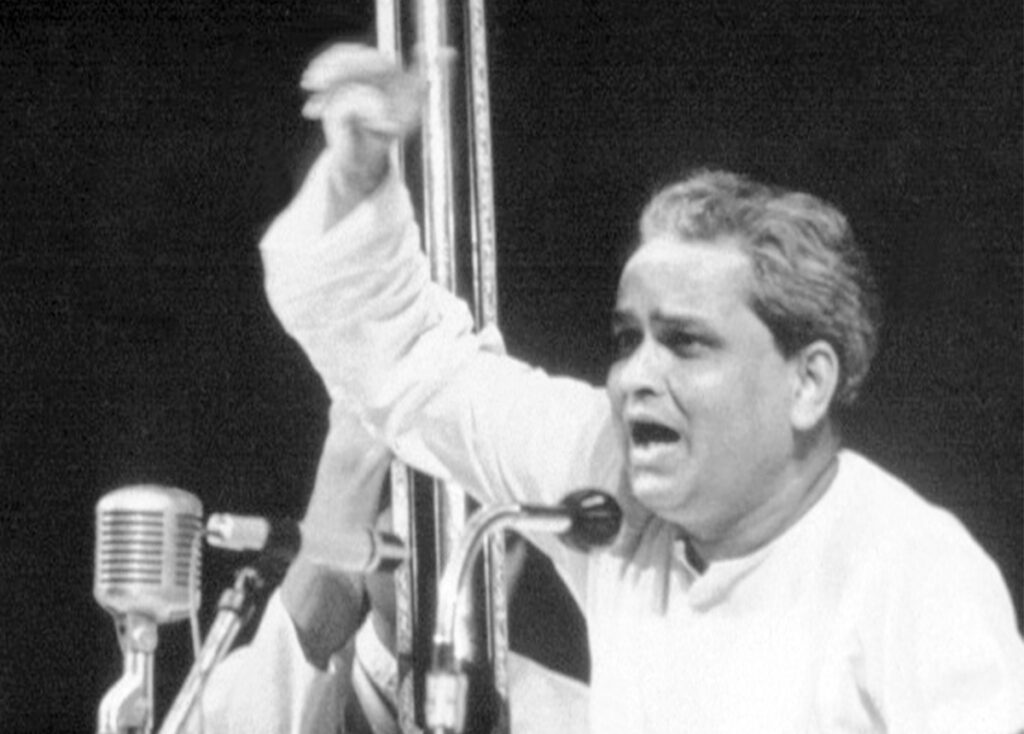Early Life
Shivaputra Siddharamaiyya Komkali, popularly known as Kumar Gandharva was born on 8th April 1924 in Sulebhavi, a village in Belagavi district in Karnataka. A legendary hindustani classical vocalist whose out-of-box thinking led to a discovery of an original and distinct style of singing which has made him a cult figure of hindustani classical music. As this year marks the birth centenary of the genius, let us try to know a little about what a giant of musician Kumar Ji was.
Music was an integral part of the Komkali household. Shivputra Komkali’s father was a huge fan of the legendary marathi singer and actor Bal Gandharva and his elder brother was a passionate singer. Thus, young Shivputra constantly remained in a musical atmosphere from his childhood. As Chadrashekhar Rele, Kumar Ji’s childhood friend and guru bandhu, recounts in the documentary on Pt. Kumar Gandharva ‘Hans Akela’ by Jabbar Patel that as a child Shivputra didn’t sing at all till the age of eight. He used to sit beside his brother and listen to him singing with tanpuras. One day the young lad suddenly started singing which revealed the prodigious talent inside him, leaving his family startled.
His father was the seer of a Shaiv hermitage in their village and when the head of the hermitage heard the young Shivputra sing, he was so pleased that he pronounced him as ‘Gandharva’ and from then he was known as ‘KUMAR GANDHARVA’. By the time he was 12 years old, Kumar Gandharva was known to imitate and exactly reproduce the records of the legends like Abdul Karim Khansahab, Faiyyaz Khansahab and this was tested by the King of Sawantwadi who played a new and never heard record of Rehmat Khansahab singing ‘Chedo Na Maikaji’ in Raag Bhairavi and witnessed Kumar Ji’s effortless singing along with the record.
Music Education
Moving forward, Kumar Ji became a disciple of eminent musicologist Shri B.R. Deodhar at Deodhar School of Music in Mumbai. His approach towards music was very open – minded. He had collected a vast number of bandishes of different gharanas; he would then explain to Kumar Ji the nuances of different gharanas and ask him to enjoy each of them. He would also analyze different kinds of music and discuss it with him which benefited Kumar Ji immensely. In his early 20s, he successfully completed his education with a hope of starting a long and fruitful career.
An unfortunate disease and its recovery
Soon thereafter, around 1947 he was diagnosed with Tuberculosis and was told by the doctors that singing would be fatal for him. He was advised to move to a drier climate and thus he shifted to Dewas in Madhya Pradesh. He was bedridden and had stopped singing but never ceased to contemplate over his music. In these difficult circumstances, his attention drew to the folk music of the region.
In the year 1952, an antibiotic Streptomycin which could cure tuberculosis was introduced in India. Kumar Ji slowly recovered but one of his lungs was damaged due to the ailment and he could not sing the way he originally used to do it. Thus he had to alter his technique of singing. He used to say that, while recovering, he took inspiration from a sparrow which visited his room and in spite of its small size could produce substantial volume.
He gave his first public performance in December 1953 in Allahabad to a jam packed audience. Kumar Ji started his concert with Raga Lankeshwari and gave a memorable performance which put to rest the curiosity of many who had come to witness the concert as Kumar Ji was performing almost after five-six years.
His contribution to Indian Classical Music
According to his senior disciple Pt. Satyasheel Deshpande Ji, Kumar Ji’s contribution to Indian classical music is that he did not follow any particular sequence in presenting Khayal composition, as any classical singer would try to follow and master the sequence of Ashtang – Alap, Bol Alap, Bol Taan etc. in his entire lifetime. But, Kumar Ji took into consideration the imagery of a composition and he would present the best suited facet of Ashtang in that particular bandish and would avoid others.
Kumar Ji had a distinct interpretation of anything he sang, from traditional ragas to complicated ones or be it folk songs, bhajans or natyasangeet. He created ‘Dhun Ugam Ragas’ like — Madhsurja, Ahimohini, Saheli Todi, Beehad Bairav, Lagan Gandhar, Sanjaari, Maalvati, which were derived from folk tunes. He used to say that Ragas are not created but discovered. He created a whole series of concert programmes which would consist of a set of ragas and folk songs arranged in a precise order with a common theme. The most famous of these are the seasonal theme programmes “Geet Varsha”, “Geet Hemant”, and “Ritu Raaj”. Kumar Ji also sang Bhajans from both the Bhakti streams of Sagun as well as Nirgun, all in his unique style. Kumar Ji’s tribute of Natyageet to legendary singer and actor Pt. Balagandharva is popular and loved.
Kumar Ji as a Guru
His shishya Pt. Vijay Sardeshmukh remarks that “Every action of his had a thought behind it which is very important for any artist. His presentation had a lovely blend of feelings, expression and sensitivity along with that thought. I believe that the reason behind this was his musical literacy.”
As per another worthy disciple of Kumar Ji, Pt. Madhup Mudgal tells that all the material that a student requires while learning, like great knowledge of raag and taal, great compositions were available to the students. But he never spoon-fed the student and had to tread his own path. Satyasheel Ji adds to the kind of taleem Kumar Ji gave, “He never taught any student any formula to be learnt by heart, he used to demonstrate the beauty of the ragas with the help of compositions the way they were expressed by different maestros. Kumar Ji further added that he was a guide who pointed the beauty at places which he could see and now you have to find the beauty for yourself”.
Awards and Legacy
Pt. Kumar Gandharva was bestowed with the country’s second highest civilian award ‘Padma Vibhushan’ in 1990.
He breathed his last on 12th January, 1992 at his residence in Dewas, Madhya Pradesh.
Kumar Ji’s legacy is being carried forward by his daughter, Kalapini Komkali and his son Mukul Shivputra. His students namely Pt. Satyasheel Deshpande, Vidushi Shubha Mudgal, Pt. Vijay Sardeshmukh and Pt. Madhup Mudgal have made names for themselves by following his style of singing. His grandson Shri Bhuvanesh Komkali also continues to carry forward both his father and grandfather’s legacy.
His association with Ahmedabad
Kumar Ji had a great interest in architecture which drew him to places like Chandigarh, Koyna Dam, Ajanta & Ellora Caves in Maharashtra for studying purpose. Talking about his association with Ahmedabad, in the 1970s, the renowned architect Balkrishna Doshi, who took inspiration from his music, invited him to visit the School of Architecture in Ahmedabad.
– Saptak Team
References:
- ‘Hans Akela’ – A documentary on Pt. Kumar Gandharva by Jabbar Patel
- https://lifestyle.livemint.com/news/big-story/kumar-gandharva-birth-centenary-year-111686303784685.html
- https://theory.tifr.res.in/~mukhi/Music/myarticle.html
Image Courtesy: Shri Srijan Deshpande

